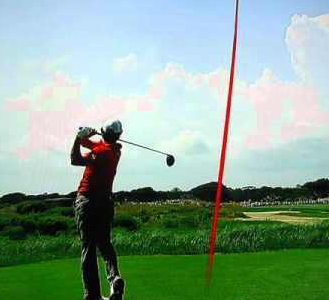
The flight of your ball can tell you almost everything about your swing.
There’s a reason you’re pushing it, or pulling it, or slicing it, or hooking it, and the quicker you understand why the ball is moving the way that it is, the better you will be at fixing your swing and making adjustments. The remainder of this article will help you do that.
High-speed cameras, launch monitors and other technological advances have provided us with a great deal of insight into why the ball does what it does, and what they’ve shown us (without getting too complex) is that the three most important things that determine the flight of your ball are the angle of the face of the club at impact, the path of your swing and your angle of attack. Each will be discussed below.
Face Angle – The angle of your face is largely responsible for the direction your ball will start to travel. If your face is open, your ball will start off to the right (assuming you’re right handed), if your face is closed, your ball will start off to the left, and if your face is completely square your ball will start off straight.
What the angle of your face doesn’t have too much to do with is the way that your ball will curve after it leaves the face of your club. That brings us to swing path.
Swing Path – Your ball curves because of the spin you impart on it when you strike it. It’s virtually impossible to hit a ball with no spin and that’s why it’s easier to play a fade or a draw. For a ball to have hook spin (or draw spin) on it, the path of your swing must be inside to out. So if you want to hit a ball that moves right to left, pretend your standing on home plate and make a swing out towards first base. Try to get your divot point right and focus on hitting the inside part of the ball. It will feel a little weird but your ball will draw.
For a ball to move left to right, just the opposite has to be happening. You don’t ever want to come over-the-top in your swing but in order to fade the ball you have to try to swing more across the ball. It’s important to realize that in some instances if your ball is starting left and hooking left (a pull-hook), you’re probably coming way too far over-the-top.
Angle of Attack (AOA) – The angle of attack is simply a measure of how much you’re hitting down on the ball. If your angle of attack is too steep, you’re likely to chunk quite a few shots. If it’s too shallow, your shots will be thin. An over-the-top motion produces a rather steep AOA and the way to prevent this from happening is to swing more around your body.
So now that you understand the three major things that affect your ball flight, you can start to dissect your shots. If you’re hitting a pull-slice, you know that your face is probably closed at impact and that your swing path is over-the-top. If you’re hitting balls that start down the middle but then hook, then you know your face is square at impact but your swinging too far from the inside.
It’s always a good idea to enlist the help of a golf professional if you’re having trouble but at least now when he tells you why your ball is doing what it’s doing, you won’t be completely lost.